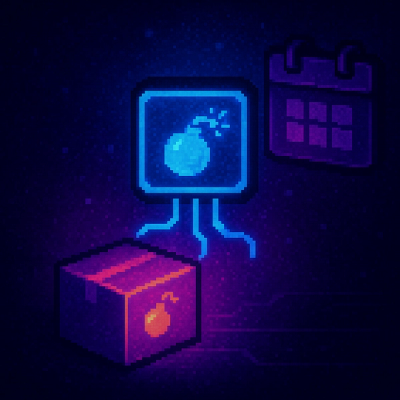
Security News
Meet Socket at Black Hat Europe and BSides London 2025
Socket is heading to London! Stop by our booth or schedule a meeting to see what we've been working on.
A simple-yet-customizable integration test tool:
3loc runs tests against existing system, sending input and expecting results. If received results are not the one expected, it will complain.
It's focused on Http services, SOAP and REST.
Test scenarii are basically JavaScript files, containing a serie of actions and expectations. You will surely need to run the same scenario multiple times, with slight changes in the test data: body sent to the tested WebService, or expected status code.
We called them fixtures, and you can externalize them in a dedicated file (multiple format are supported). In fact, the fixture file is the entry point when using 3loc, as it defined the scenario file used.
3loc is built upon Node.js 4+. You'll need to install it on your computer to use it.
As 3loc uses libXML.js, which requires some C++ compilation, you'll also need a C++ compiler (gcc or Visual Studio Community Edition for example).
Once you have installed Node and a C++ compiler, run the following command to install
npm install --global 3loc
(then have a cup of coffee)
From a command line or a terminal, run
run path/to/fixture.yml
CLI options are documented:
run
Test fixtures are used to add some dynamicity to your scenario files. This is an example:
return () =>
run(request({
url: 'http://api.wolframalpha.com/v2/query?input=<$ input $>&appid=<$ appId $>&includepodid=Result'
})).
then(expectStatusCode(<$ status $>)).
then(expectXPathToEqual('//pod[id="Result"]//plaintext', '<$ sum $>'));
It makes an Http call to the Wolfram API, get and parse the XML content, checks the received status code and check the result with an XPath expression.
See thoses <$ $> placeholders (input, sum...) ? they are replaced with the provided test data.
YAML is probably the best choice to write your fixtures. Here is the YAML file for the above scenario:
scenario: ./path_to/my-scenario.scn
appId: HLJL66-4W3HPXYYP8
tests:
- name: nominal case
input: 3%2B4
sum: 7
status: 200
- name: handling nulls
input: 3%2Bnull
sum: 3
status: 200
scenario is the path the the scenario file (required).
tests is an array of objects, each considered as the specific fixtures of a given test.
If 3loc find two objects in tests, it will runs the scenario twice, using the given objects.
Inside tests and in root level, you can put anything, from simple string/boolean to complex array/map structures.
The content will be used inside the scenario file:
input, sum and status are defined at test levelsappId is common to all tests (but can be overloaded per test)If you specify a name at test level, it will be used in final report.
Otherwise, a name with test number will be generated.
You can't use different scenarii for each test. If you whish, write different fixtures files.
Last but not least, a YAML file can include other YAML files, using the following macro:
config: !!inc/file configuration.yaml
The !!inc/file performs a synchronous read of the given path (relative to the including file) and is replaced by its content.
Less flexible than YAML, it suits some cases where data is mearly flat, does not share a lot of data, and when you want diffent scenarii. The CSV fixtures for the above scenario is:
scenario;name;appId;input;sum;status
./path_to/my-scenario.scn;HLJL66-4W3HPXYYP8;"nominal case";3%2B4;7;200
./path_to/my-scenario.scn;HLJL66-4W3HPXYYP8;"handling nulls";3%2Bnull;3;200
Each line will execute a different test.
scenario column contains the path the the scenario file (required).
Any other column contains data used inside test.
If you put dots in the column name, the data replace will be treeish.
For example, with a column named host.url, the replacement will be request({host: '<$ host.url $>'})
and the data is an host object containing an url property.
If you specify a name column, it will be used in final report.
Otherwise, a name with test number will be generated.
You can't share data among different tests. For that, please use a YAML fixture file.
Whatever the format used, the following considerations always apply:
scenario path is always relative to the fixture location (you can provide absolute path as well)scenario can directly contains the JavaScript code (only suit really tiny scenarii)load action for example) are relative to that folderBy default, 3loc is not really verbose.
But it can be more chatty if you configure logging: just put a logging.properties file in the execution folder.
The file syntax is a classical INI file where the category is the logger name, and the values allows to customize its parameter:
[my-logger-1]
level=error
[my-logger-2]
level=debug
The conf is regularly watched so you can change you file while 3loc is running.
By convention, each actions/expectation uses its own logger, so you can have a fine-grained tunning.
Scenario files are JavaScript files, templated with Nunjucks template language.
Obviously they must be well-formed JavaScript after the template compilation.
To improve readability, the default Nunjucks's delimiter have been changed:
Be warned that placeholders are type-aware (which is an improvment of Nunjuck behavior). For example this scenario:
load(<$ file $>)
It will compiles only if you provides a string value in the fixture file.
Boolean and number types are kepts within templates, strings fixtures are automatically enclosed in double quotes, arrays and objects are serialized into JSON.
All methods from lodash v4.0.1 are also available as Nunjuck filters:
run(request(<$ endpoint | pick('url', 'headers') $>)).
then(expectContentToInclude(<$ filename | camelCase $>))
The first method parameter is always the filtered values, and you can add extra parameters. It's strictly equivalent to write: var _ = require('lodash');
run(request(_.pick(<$ endpoint $>, 'url', 'headers'))).
then(expectContentToInclude(_.camelCase(<$ filename $>)))
You can also hardcode everything, and in that case, the fixtures file only needs to specify scenario path and a name for each tests.
Your scenario file must ends by returning either:
return Promise.resolve(18);return function() { return 18; };return function(done) { require('fs').readFile('myfile.txt', done); };
(asynchronous functions differs from synchronous function because they declare a single argument)The best thing to do is to return the result of run() or runSerial() actions.
And it's executed on Node.js.
That means that Node's API are available (through the use of require() function),
as well as 3loc own dependencies (lodash, moment, chai, joi...)
As your tests are run on Node.js, you can use the ES6 features supported from version 4.2 (arrow functions, promises, string interpolation, classes...).
All actions are JavaScript functions automatically available within scenario file (no need to require anything else). They are composable within Promises, and are intended to be used that way.
Do NOT handle promise rejections, unless your scenario needs to keep testing stuff after an error. The nominal case is to let errors bubnle an stop the current executed test.
Starts an HTTP server to listen a given url. Acceptable method can be configured, has well as response body and headers.
If a JSON body is passed, set default response content-type to application/json.
If a libXML.js Document body is pased, set default response content-type to application/xml.
You can still override the response content-type if needed.
If body is given as a function, it must return a promise fulfilled
with an object including a content property.
Request body will be automatically parsed (using the request content-type) to libXML.js Document or to JSON object for further processing. Otherwise, the request body is passed as a string.
listen({
port: 4000,
url: '/my-api',
method: 'POST',
body: '{"msg": "response sent"}',
headers: {
'content-type': 'application/json',
'x-custom': 'custom'
},
code: 200
}).then(...)
Logger name: act:listen
Loads file content as a string. Typically used to read request/response bodies, XSD files...
load('./path_to/file.txt', 'ascii').then(...)
Logger name: act:load
Renders Nunjucks template with given data. See Nunjucks templating language, with the specific delimiters (for readability in scenarii files)
render('Hello <$ name $> !', {name: 'James'}).then(...)
If content is given as a function, it must return a promise fulfilled
with an object including a content and path properties.
Logger name: act:render
Makes an HTTP(s) request on a given url. The HTTP method, the headers and the ability to follow redirections are configurable.
If a JSON body is passed, set default request content-type to 'application/json'. If a libXML.js Document body is pased, set default request content-type to 'application/xml'. You can still override the request content-type if needed.
Request body will be automatically parsed (using the request content-type) to libXML.js Document or to JSON object for further processing. Otherwise, the request body is passed as a string.
request({
url: 'http://localhost:8080/my-api',
method: 'PUT',
body: '{"msg": "request sent"}',
headers: {
'content-type': 'application/json',
'x-custom': 'custom'
},
followRedirect: true
}).then(...)
If you need to pass query parameters, please encode them with the url.
If body is given as a function, it must return a promise fulfilled
with an object including a content property.
Logger name: act:request
Runs synchronously a given function, with provided data, and wrap to Promise for next actions and expectations. A must-have when starting a new scenario.
run(request({url: 'http://somewhere.com/'}))
fs {Function} - function executed
data = {} {Object} - optionnal data given as function argument
returns {Promise} fulfilled with the function result
Logger name: act:run
Runs an array of function serially, passing result of task N as parameter of task N+1.
Beware that you must pass an array functions. Don't give promises, or they will be started all in once.
runSerial([
() => Promise.resolve(1),
p => Promise.resolve(p + 1)
].then(result => ...) // result === 2
Logger name: act:serial
All actions are JavaScript functions automatically available within scenario file (no need to require anything else). They are composable within Promises, and are intended to be used that way.
Do NOT handle promise rejections, unless your scenario needs to keep testing stuff after an error. The nominal case is to let errors bubnle an stop the current executed test.
Checks that received content includes the given element, or matches the given pattern.
run(load('my-file.txt')).
then(expectcontentToInclude('Hi !'))
Logger name: expect:content
Checks that a given status code has been received.
run(request({'http://somewhere.com/api'})).
then(expectStatusCode(404))
Logger name: expect:status
Validates incoming content against a given XSD content. Use libXML.js internally. XSD and XML content can be passed as plain string, or as libXML.js's Document objects
If xsd is given as a function, it must return a promise fulfilled
with an object including a content property.
run(request({'http://somewhere.com/api'})).
then(expectToMatchXsd(load('schema.xsd')))
Logger name: expect:xsd
FAQs
A simple-yet-customizable integration test tool
We found that 3loc demonstrated a not healthy version release cadence and project activity because the last version was released a year ago. It has 2 open source maintainers collaborating on the project.
Did you know?

Socket for GitHub automatically highlights issues in each pull request and monitors the health of all your open source dependencies. Discover the contents of your packages and block harmful activity before you install or update your dependencies.

Security News
Socket is heading to London! Stop by our booth or schedule a meeting to see what we've been working on.

Security News
OWASP’s 2025 Top 10 introduces Software Supply Chain Failures as a new category, reflecting rising concern over dependency and build system risks.

Research
/Security News
Socket researchers discovered nine malicious NuGet packages that use time-delayed payloads to crash applications and corrupt industrial control systems.